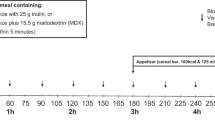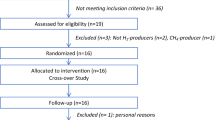Abstract
Objective:
The administration of a fermentable dietary fibre (oligofructose) in rats increases satietogenic gut peptides and lowered spontaneous energy intake. The aim of the study was to assess the relevance of those effects of oligofructose on satiety and energy intake in humans.
Design:
Single-blinded, crossover, placebo-controlled design, pilot study.
Subjects:
Volunteers included five men and five women aged 21–39 years, BMI ranging from 18.5 to 27.4 kg/m2, were randomly assigned as described below.
Interventions:
Subjects were included in two 2-week experimental phases during which they received either fibre (oligofructose (OFS)) or placebo (dextrine maltose (DM)); a 2-week washout period was included between crossover phases. In total, 8 g OFS or 8 g DM were ingested twice daily (16 g/day in total). Energy intake, hunger, satiety, fullness and prospective food consumption were assessed with analogue scales at the end of each experimental phase.
Results:
During breakfast, OFS significantly increases the satiety (P=0.04) without any difference on other sensations as compared to DM treatment periods. After lunch, no significant differences are observed between treatment period. At dinner, OFS significantly increases satiety (P=0.04), reduces hunger (P=0.04) and prospective food consumption (P=0.05). The energy intake at breakfast and lunch are significantly lower (P=0.01, 0.03, respectively) after OFS treatment than after DM treatment. Total energy intake per day is 5% lower during OFS than in DM period.
Conclusion:
Oligofructose treatment increases satiety following breakfast and dinner, reduces hunger and prospective food consumption following dinner. This pilot study presents a rationale to propose oligofructose supplements in the management of food intake in overweight and obese patients.
Sponsorship:
This project is supported by an FSR grant from the Université catholique de Louvain.
This is a preview of subscription content, access via your institution
Access options
Subscribe to this journal
Receive 12 print issues and online access
$259.00 per year
only $21.58 per issue
Buy this article
- Purchase on Springer Link
- Instant access to full article PDF
Prices may be subject to local taxes which are calculated during checkout



Similar content being viewed by others
References
Archer BJ, Johnson SK, Devereux HM, Baxter AL (2004). Effect of fat replacement by inulin or lupin-kernel fibre on sausage patty acceptability, post-meal perceptions of satiety and food intake in men. Br J Nutr 91, 591–599.
Cani PD, Daubioul CA, Reusens B, Remacle C, Catillon G, Delzenne NM (2005a). Involvement of endogenous glucagon-like peptide-1(7–36) amide on glycaemia-lowering effect of oligofructose in streptozotocin-treated rats. J Endocrinol 185, 457–465.
Cani PD, Dewever C, Delzenne NM (2004). Inulin-type fructans modulate gastro-intestinal peptides involved in appetite regulation – Glucagon-like peptide-1 and Ghrelin – in rats. Br J Nutr 92, 521–526.
Cani PD, Neyrinck AM, Maton N, Delzenne NM (2005b). Oligofructose promotes satiety in rats fed a high-fat diet: involvement of glucagon-like peptide-1. Obes Res 13, 1000–1007.
Daubioul C, Rousseau N, Demeure R, Gallez B, Taper H, Declerck B et al. (2002). Dietary fructans, but not cellulose, decrease triglyceride accumulation in the liver of obese Zucker fa/fa rats. J Nutr 132, 967–973.
Davy BM, Melby CL (2003). The effect of fiber-rich carbohydrates on features of Syndrome X. J Am Diet Assoc 103, 86–96.
Delzenne N, Cherbut C, Neyrinck A (2003). Prebiotics: actual and potential effects in inflammatory and malignant colonic diseases. Curr Opin Clin Nutr Metab Care 6, 581–586.
Delzenne NM (2003). Oligosaccharides: state of the art. Proc Nutr Soc 62, 177–182.
Flint A, Raben A, Astrup A, Holst JJ (1998). Glucagon-like peptide 1 promotes satiety and suppresses energy intake in humans. J Clin Invest 101, 515–520.
Flint A, Raben A, Ersboll AK, Holst JJ, Astrup A (2001). The effect of physiological levels of glucagon-like peptide-1 on appetite, gastric emptying, energy and substrate metabolism in obesity. Int J Obes Relat Metab Disord 25, 781–792.
Howarth NC, Saltzman E, Roberts SB (2001). Dietary fiber and weight regulation. Nutr Rev 59, 129–139.
Howarth NC, Saltzman E, McCrory MA, Greenberg AS, Dwyer J, Ausman L et al. (2003). Fermentable and nonfermentable fiber supplements did not alter hunger, satiety or body weight in a pilot study of men and women consuming self-selected diets. J Nutr 133, 3141–3144.
Jenkins DJ, Kendall CW, Vuksan V (1999). Inulin, oligofructose and intestinal function. J Nutr 129, S1431–S1433.
Nuttall FQ (1993). Dietary fiber in the management of diabetes. Diabetes Rev 42, 503–508.
Piche T, des Varannes SB, Sacher-Huvelin S, Holst JJ, Cuber JC, Galmiche JP (2003). Colonic fermentation influences lower esophageal sphincter function in gastroesophageal reflux disease. Gastroenterology 124, 894–902.
Raben A, Tagliabue A, Astrup A (1995). The reproducibility of subjective appetite scores. Br J Nutr 73, 517–530.
Roberfroid MB, Delzenne NM (1998). Dietary fructans. Annu Rev Nutr 18, 117–143.
Van Loo J, Coussement P, de Leenheer L, Hoebregs H, Smits G (1995). On the presence of inulin and oligofructose as natural ingredients in the western diet. Crit Rev Food Sci Nutr 35, 525–552.
Van Loo J, Franck A, Roberfroid M (1999). Functional food properties of non-digestible oligosaccharides. Br J Nutr 82, 329.
Venn BJ, Mann JI (2004). Cereal grains, legumes and diabetes. Eur J Clin Nutr 58, 1443–1461.
Verdich C, Flint A, Gutzwiller JP, Naslund E, Beglinger C, Hellstrom PM et al. (2001). A meta-analysis of the effect of glucagon-like peptide-1 (7–36) amide on ad libitum energy intake in humans. J Clin Endocrinol Metab 86, 4382–4389.
Acknowledgements
We thank all the subjects who participated in this study, as well as the Paul Lambin Institute, Haute Ecole Leonard de Vinci (dietetic section) for their help in elaborating the test meals. This work was supported by an FSR grant from the Université catholique de Louvain. PDC is teaching assistant, Université catholique de Louvain, Brussels, Belgium.
Author information
Authors and Affiliations
Corresponding author
Additional information
Guarantors: NM Delzenne and PD Cani.
Contributors: PDC performed the experiments, did the statistical analysis and drafted the manuscript. EJ carried out the experiments. YH took part in the coordination of the study. NMD coordinated the study. All authors contributors helped with the revision of the paper.
Rights and permissions
About this article
Cite this article
Cani, P., Joly, E., Horsmans, Y. et al. Oligofructose promotes satiety in healthy human: a pilot study. Eur J Clin Nutr 60, 567–572 (2006). https://doi.org/10.1038/sj.ejcn.1602350
Received:
Revised:
Accepted:
Published:
Issue Date:
DOI: https://doi.org/10.1038/sj.ejcn.1602350
Keywords
This article is cited by
-
Effect of inulin on breath hydrogen, postprandial glycemia, gut hormone release, and appetite perception in RYGB patients: a prospective, randomized, cross-over pilot study
Nutrition & Diabetes (2024)
-
Microbiota-gut-brain axis: relationships among the vagus nerve, gut microbiota, obesity, and diabetes
Acta Diabetologica (2023)
-
Manipulation of intestinal microbiome as potential treatment for insulin resistance and type 2 diabetes
European Journal of Nutrition (2021)
-
Microbial regulation of organismal energy homeostasis
Nature Metabolism (2019)
-
Gut microbial metabolites in obesity, NAFLD and T2DM
Nature Reviews Endocrinology (2019)



